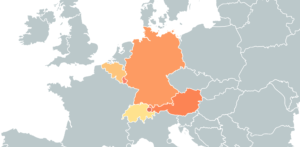German Grammar Sounds Worse Than It Is
I’m sure you’ve heard the scary reputation of German grammar. Lots of genders, complicated rules, and plenty of exceptions to keep in mind. But, those are all just myths. Learning German grammar is just like learning any other language. You need to understand the basic rules and do your best to use them. To make learning it easier, we collected the most important rules of German grammar, and a handy explanation of the German grammatical cases.
German Cases
Even in English, you use grammatical cases. These categories signal what function a word fulfills in a sentence. But, German relies a little bit heavier on cases. Adjectives, articles, and pronouns all need to fit the case in your speech. So, it’s best to understand the difference between German cases early on.
There are four cases in German:
- Nominitive: Used for words that are subjects of a phrase or sentence
- Accusative: Indicates that a word is the direct object of a verb
- Dative: Indicates that a word is the indirect object of a verb
- Genitive: Demonstrates possession
Nominitive Case
The nominative case is the simplest of German grammatical cases. As previously stated, the nominative case is used for words that are the subject of German phrases or sentences. It is appropriate to think of the nominative as the “base” case in German grammar. Words in the nominative case do not experience any declension and are written exactly as they appear in the dictionary form.
Accusative Case
The accusative case is used primarily to show that a noun is the direct object of a verb and is receiving the action of that verb. In German, certain prepositions always take the accusative case.
Common German prepositions that always take the accusative case:
- bis – to (until, as far as)
- ohne – without
- durch – through
- um – around
- für – for
- wider – against (contrary)
- gegen – against (positionally)
Note that with the exception of the nominative “base” case, all grammatical cases in German are marked by declensions. These declensions affect nouns and their definite articles, pronouns and adjectives. Declensions will be covered in the next section of this text.

Dative Case
The dative case is used primarily with indirect objects. These are nouns that do not receive the action of a transitive verb, but are affected by the action of the transitive verb. An example of an indirect object in English can be seen in the following sentence: “I gave my sister the book”.
In this example, “my sister” is the indirect object. “My sister” does not receive the action of the verb. It’s the book (the direct object) that is given, but “my sister” is affected by the verb’s action. She has now received “the book”.
Certain prepositions always take the dative case in German. A list of the more common prepositions is provided below.
Common German prepositions that always take the dative case:
- aus – out of/from
- bei – at/by
- mit – with
- nach – after
- seit – since
- von – from (of)
- zu – to
Genitive Case
The genitive case is used to convey possession or inclusion. Generally speaking, the German genitive case corresponds to English phrases formed with the preposition “of”. Similar to the accusative case, there are certain German prepositions that always take the genitive case.
Common German prepositions that always take the genitive case:
- anstatt – instead of
- trotzdem – despite (in spite of)
- während – during
- wegen – on account of
Other Prepositions
Other prepositions, however, take more than one case, depending upon their context or situation. The following prepositions take either the dative or accusative case:
| an |
at, on, to | auf |
on, upon |
| hinter |
behind | vor |
before, in front of |
| in |
in, into | über |
over |
| unter |
under, among | zwischen |
between |
| neben |
beside |
With these prepositions, the dative case expresses an action that takes place in a fixed position or location, while the accusative expresses motion toward or into a place. It is the difference, inexact English, between in and into, or on and upon. This is an important distinction in German and must be observed. Study the examples that follow:
- Sie steht auf der Brücke. – She is standing on the bridge.
- Sie läuft auf die Brücke. – She is running (on)to thebridge.
- Wir sind in der Kirche. – We are in the church.
- Wir gehen in die Kirche. – We are going into the church.

The Grammar Behind German Nouns
German nouns are much easier to master after you learned about the cases. With nouns, there are only a few rules to keep in mind. Just like in English, nouns signal people, places, things, and ideas. But, there are a few differences between the grammar of English and German nouns.
1. German Nouns Are Always Capitalized
This makes it easy for you to recognize which words in the sentence are nouns.
2. German Nouns Have Three Genders
German nouns can be masculine (der), feminine (die), and neuter (das). Of course, this is a new concept for English speakers. It’s best to learn the gender of the noun together with the word as you’re enhancing your vocabulary.
How to Tell the Gender of a Noun
It’s fair to wonder how you can differentiate between the three genders. Well, there are some tricks you can use to guess what gender it is. Here are a couple of tips you can use to identify the German gender:
- Biological gender: If a noun describes a person or profession, the gender is very logical. Male nouns are masculine, female nouns are feminine, and children are usually neuter. (der Mann (man), die Frau (woman), das Baby (baby))
- Gender categories: Some categories all have the same gender. For example, weather-related words are usually masculine (der Schnee (snow). And colors are usually neuter (das Blau (blue)).
- Look at the ending: Word endings are telltale signs for the gender.
- DER: -ant/-ent, -ich, -ling- ismus, -ist, -or, -er
- DIE: -e, -heit/keit, -ung, -schaft, -ie, -anz/enz, -ik, -ei, -ion, -ität, -ur
- DAS: -chen, -lein, -ment, -tum, -um
3. German Nouns Change When They Turn Plural
The first step of putting a German noun from singular to plural is to change the article to “die”. Plural German nouns don’t have a gender. Then, one of three things can happen to a noun:
- You add one of the following endings to the noun: –s, –n, –en, –e, –er
- Change the vowel in the word to an umlaut vowel (a to ä)
- Or both: add an ending and change the vowel
Sometimes, rarely, nothing happens to a noun when you ‘re putting it into plural. It’s also best to learn how the plural works as you’re learning the noun.
There’s a lot more to German nouns of course. We can also show you tips and tricks to tell the gender of German nouns apart. Try and find out the most you can about them to reach fluency.

How to Conjugate German Articles
Articles are the word you use to describe the definiteness of a noun. In English, the definite article is “the”, and the indefinite articles are “a” and “an”. But, in German there are a lot more articles. You need to adjust both definite and indefinite articles to fit the gender, number, and case of the noun they represent.
The Grammar of Definite German Articles
The three main definite German articles are “der”, “die”, and “das”. These correspond with the gender of the noun. So, “der” is masculine, “die” is feminine, and “das” is neuter. But, you also have to use declension to fit the case and number of the noun. Here’s a handy table to show you all the different variations of German definite articles:
Singular |
|
Plural |
|||
Masculine |
Feminine |
Neuter |
|
All Genders |
|
Nominative |
der (the) |
die (the) |
das (the) |
die (the) |
|
Accusative |
den |
die |
das |
die |
|
Dative |
dem |
der |
dem |
den |
|
Genitive |
des |
der |
des |
der |
|
Indefinite Articles in German Grammar
When you’re not talking about a specific noun, you need to use indefinite articles. The base German indefinite article is “ein”. But, it’s also conjugated to fit the gender, number, and case of the noun. Naturally, there is no plural indefinite article. But here are all the different version of “ein” you need to know.
Singular |
|
Plural |
|||
Masc. |
Fem. |
Neut. |
|
All Genders |
|
Nominative |
ein (a/an) |
eine (a/an) |
ein (a/an) |
— |
|
Accusative |
einen |
eine |
ein |
— |
|
Dative |
einem |
einer |
einem |
— |
|
Genitive |
eines |
einer |
eines |
— |
|
Learn more about German articles to master them all.
Verbs in German Grammar
Luckily, German verbs are very easy to master. While you need to learn all the tenses, it’s fairly straightforward. Once you learn the rules, you know them for life. There are very very few exceptions are irregularities to keep in mind.
One thing that you should be aware of is that German verbs are conjugated differently for all 6 personal pronouns. So, “I”, “you”, “he/she/it”, “we”, “you”, and “they” all have different version of the verb. While this is common in most European languages, it’s not common in English.
If you want to learn more about the conjugation and tenses of German verbs, this handy guide can show you everything you need to know.
The Grammar of German Adjectives
You use adjectives to describe nouns. So, just like articles, you need to use declensions to fit the adjective to the noun. You need to add one of the following endings to the adjective, depending on the gender, number, and case of the noun.
|
Singular |
|
Plural |
|||
|
Masc. |
Fem. |
Neut. |
|
All Genders |
|
| Nominative |
—er |
—e |
—es |
—e |
|
| Accusative |
—en |
—e |
—es |
—e |
|
| Genitive |
—es |
—er |
—es |
—er |
|
| Dative |
—em |
—er |
—em |
—en |
|
Comparative and Superlative Adjectives in German Grammar
Of course, adjectives need to escalate. Whether you’re comparing two things or you’re declaring the superiority of one, you can do that by changing the meaning of the adjective slightly. In German grammar, this is fairly easy. For comparative adjectives, you add “-er”, just like in English. And for the superlative adjective, you add “-(e)st”. But, with certain adjectives, you also have to add an umlaut. Here are a few examples of comparative and superlative adjectives for you.
|
Comparitive |
Superlative |
||||
| klein | small | kleiner | smaller | kleinst | smallest |
| leise | quiet | leiser | quieter | leisest | quietest |
| arm | poor | ärmer | poorer | ärmst | poorest |
| jung | young | jünger | younger | jüngst | youngest |
While these are the most important grammar rules regarding German adjectives, there are a lot more. Learn more about German articles to master them for fluency.

Master German Pronouns
You may not even realize how often you use pronouns every day. These are the words you use to replace nouns. For example, personal pronouns in English are “you”, “he”, and “they”. And just like in English, German has many different kinds of pronouns. And they all use declensions to fit the case.
- Personal
- Reflexive
- Demonstrative
- Interrogative (question words)
- Relative
- Indefinite
- Possessive
The most important to master of these are personal pronouns. Almost every German sentence has these. And when you’re conjugating German verbs, you’ll definitely need them. Here are all the personal pronouns you need to know in German.
Nominative |
Accusative |
Dative |
|
ich I |
mich me |
mir (to) me |
|
du you (inf. sing.) |
dich you |
dir (to) you |
|
er he, it |
ihn him, it |
ihm (to) him, it |
|
sie she, it |
sie her, it |
ihr (to) her, it |
|
es it |
es it |
ihm (to) it |
|
wir we |
uns us |
uns (to) us |
|
ihr you (inf. pl.) |
euch you |
euch (to) you |
|
sie they |
sie them |
ihnen (to) them |
|
Sie you(formal. sing. & pl.) |
Sie you |
Ihnen (to) you |
But, you should definitely invest some time to learn all the German pronouns well. Mastering this part of German grammar will pay off in the long run. As you can see, every German pronoun has a corresponding English equivalent, so it’s more like a vocabulary list you need to know, not an entirely new concept altogether.

Create Grammatically Correct German Sentence Structures
Now that you mastered all parts of German grammar, it’s time to put them together. Here are all the basics rules of the German word order you need to know to put your grammar knowledge to use.
1. Basic Sentence Grammar
Basic sentences have the same word order in English and in German. They’re both SVO (subject-verb-object) languages. Here’s an example:
- The dog plays with the ball. – Der Hund spielt mit dem Ball.
2. If a Sentence Has Two Verbs
Very often, your German sentence will have two verbs. For example, when you’re speaking in past tense. Then one of the verbs is a helper verb. You conjugate this, and it comes in second place after the subject. The other verb is the main verb. This gives the sentence its meaning. And you place it at the very end of the sentence. Here are some examples:
- I have rented a bicycle. – Ich habe ein Rad gemietet.
- You must take a detour. – Sie müssen einen Umweg machen.
- Mr. Meier can help you. – Herr Meier kann Ihnen helfen.
3. Forming Grammatically Correct German Questions
You can ask questions in German in two ways. You either use inverted word order, or you use a question word. Here are the most common question words in German:
- why – warum
- what – was
- when – wann
- how – wie
- where – wo
- where from – woher
- where to – wohin
- who – wer
- who(m) – wen
- whose – wessen
- to/from whom – wem
4. The Grammar Behind the Inverted Word Order
If the sentence starts with a conjunction, or any word other than a subject, that the word order changes. The verb goes at the very end of the sentence. This also happens with dependent sentence halves connected by conjunctions. Here are some examples:
- We drank some wine at the restaurant. – Im Restaurant haben wir Wein getrunken.
- Yesterday we were in Berlin. – Gestern waren wir in Berlin.
- He says that the have no vacant rooms – Er sagt, dass kein Zimmer frei ist.
- I don’t know whether people come today. – Ich weiss nicht, ob heute Leute kommen.
5. Negative Sentences in German Grammar
Forming negative sentences is easy in German. All you have to do is insert the words “nicht” (not) or “kein” (no).
- I cannot sing. – Ich kann nicht singen.
- I have no money. – Ich habe kein Geld.
Of course, even with sentence structures, there’s always more to learn. Here’s a handy guide to master the German word order efficiently.

Learn German Grammar Through Common Phrases
Learning German grammar doesn’t have to be a dreaded process. You can actually just pick up all of these rules naturally through everyday German sentences. When you learn the most common phrases, you instantly learn the correct grammar. And the best resource you can use to learn these phrases is OptiLingo.
OptiLingo is an app that gets you to fluency fast. It includes the exact vocabulary real Germans use. And, most importantly, it makes you speak the language. So, you can practice your German skills immediately. That’s how you achieve the best results as you’re progressing towards fluency. Guarantee your German success when you download OptiLingo!








